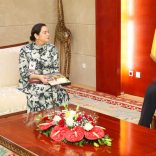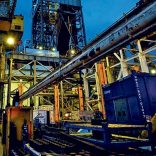Mozambique: President of the Republic encourages expansion of World Vision's actions
International team set to investigate ‘Greatest Extinction on Earth’ in Mozambique

Twitter @raraujopaleo (File photo)
An international team will conduct an investigation in Mozambique on the impact of the greatest extinction of life on earth, 252 million years ago. The announcement was made on Monday.
Portuguese palaeontologist Ricardo Araujo will lead the team. Araújo, from the Institute for Plasmas and Nuclear Fusion of the Instituto Superior Técnico and the Museum of Lourinhã (Portugal), who has just won a grant from National Geographic magazine to support the research, explained to Lusa that Mozambique was one of the few places in the world whose layers of rock record the transition between Permian and Triassic eras about 252 million years ago.
It was during this period, which also marks the separation between the geological ages of the Paleozoic and the Mesozoic, that “the greatest extinction on Earth, where about 95 percent of living beings died” occurred.
The extinction was “absolutely overwhelming and incomparably larger than any other period in Earth’s history”, and was caused by a massive volcanic eruption in Siberia which released tons of greenhouse gases, leading to profound changes in climate and life on Earth.
Using stratigraphy, prospecting and excavation, researchers are hoping to find fossils belonging to new species of fauna and flora near Lake Niassa, in the Mozambican province of the same name.
“About 95 percent of the species became extinct, so if any Triassic species is found it will be very interesting to see what kind of species are most affected by extinctions, whether there is any difference in size of animals or in terms of trophic chain, if they were herbivores or carnivorous, and what kind of animals survived this extinction,” the team leader said.
The multidisciplinary team, composed of palaeontologists, geologists and engineers, hopes to discover the remains of Lystrosaurus, an ancestors of mammals that survived extinction and whose remains have been excavated in South Africa , Antarctica, Zambia and Russia.
Araújo explained that it was during the transition between the Permian and the Triassic that the ancestors of the main groups of vertebrate animals present on Earth today originated, justifying any investigation to better understand their origin and evolution over millions of years.
In addition to Ricardo Araújo, the international team includes Portuguese Rui Martins, from the Institute for Plasmas and Nuclear Fusion of Instituto Superior Técnico, Mozambicans Dino Milisse and Nelson Nhamutole, of the National Museum of Geology of Mozambique, Kenneth Angielczyk of the Field Museum, Jim Crowley of Boise State University, Sterling Nesbitt of Virginia Technical University, and South African Roger Smith of the Iziko Museum.












Leave a Reply
Be the First to Comment!
You must be logged in to post a comment.
You must be logged in to post a comment.